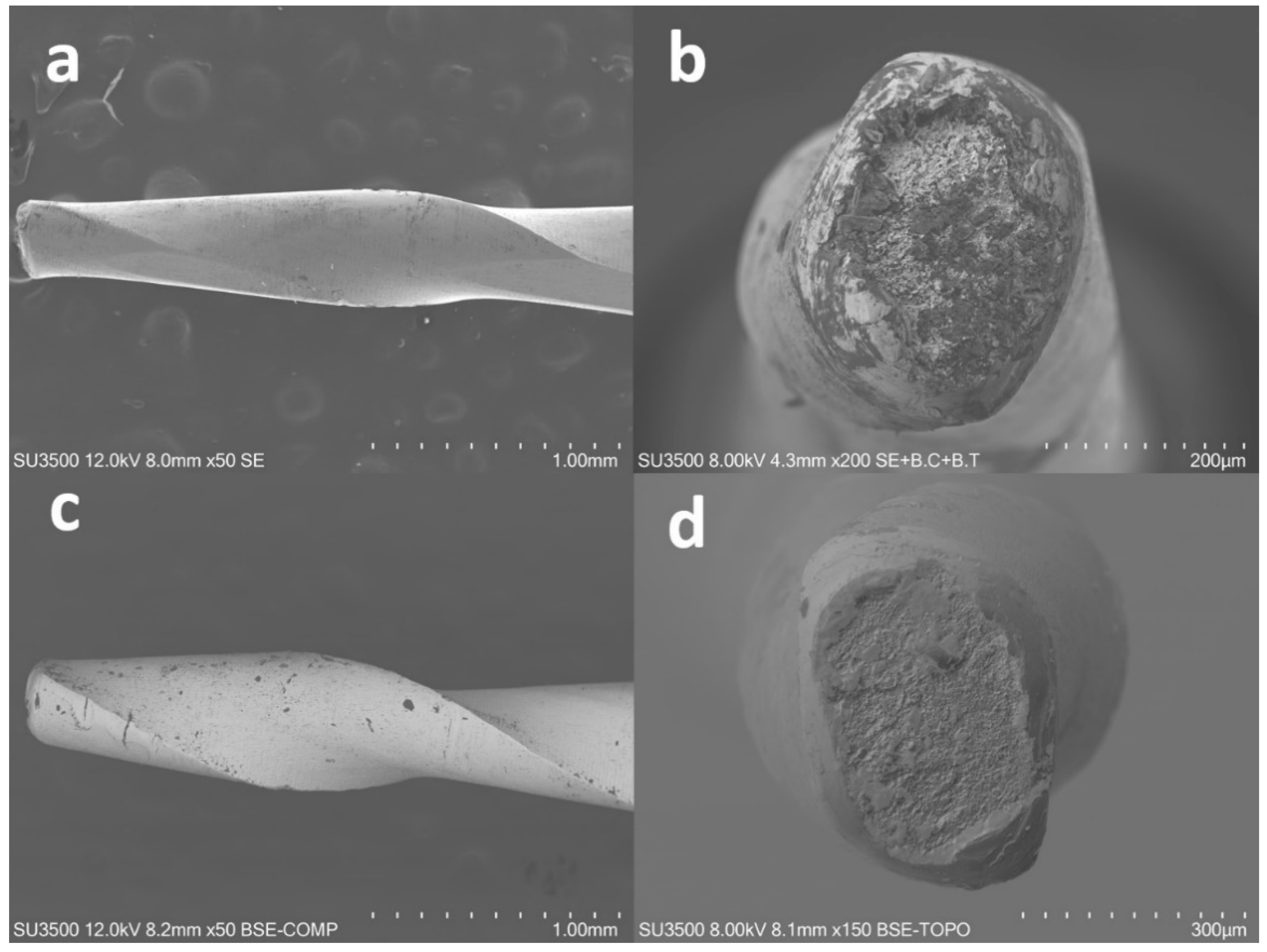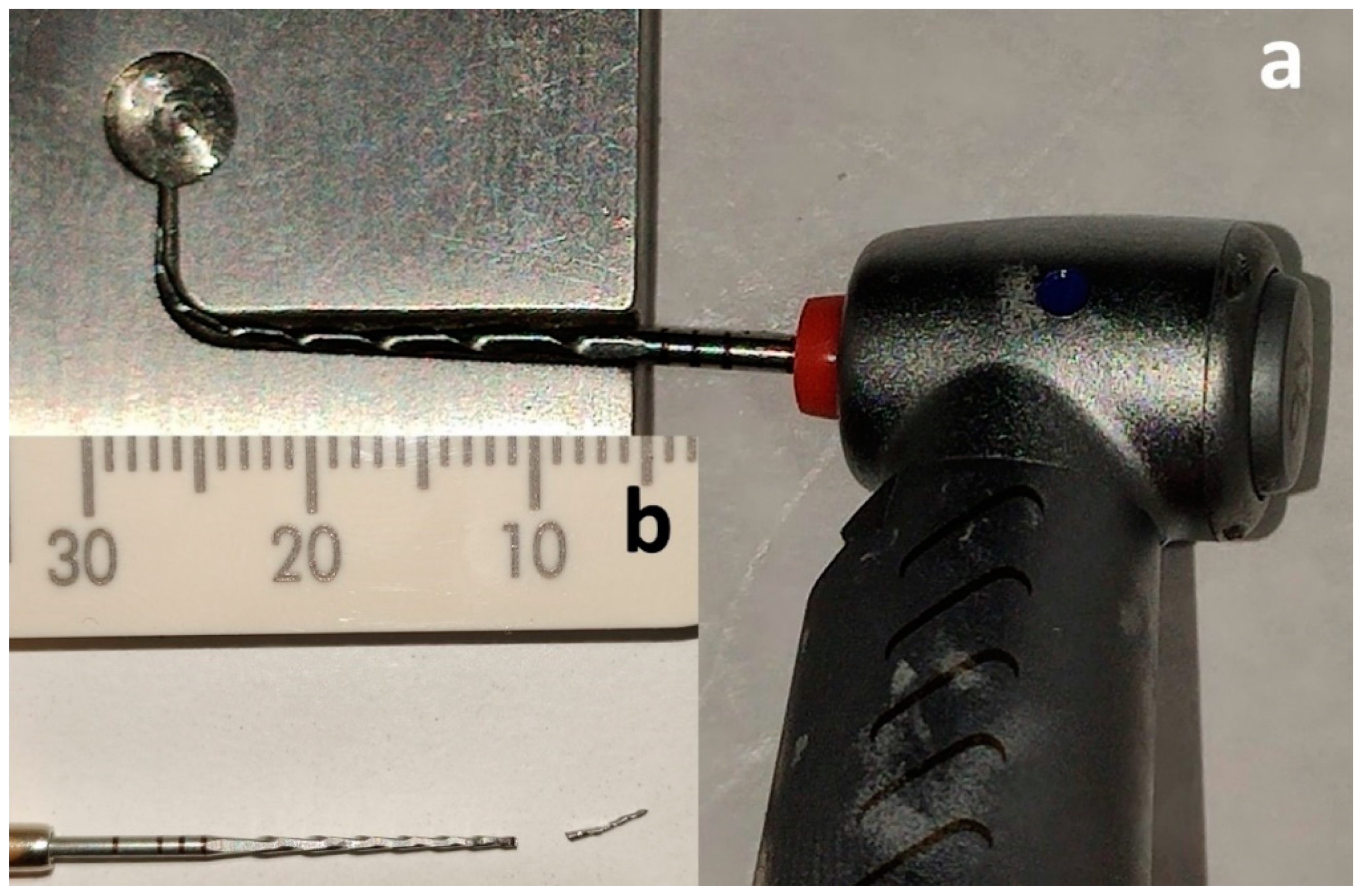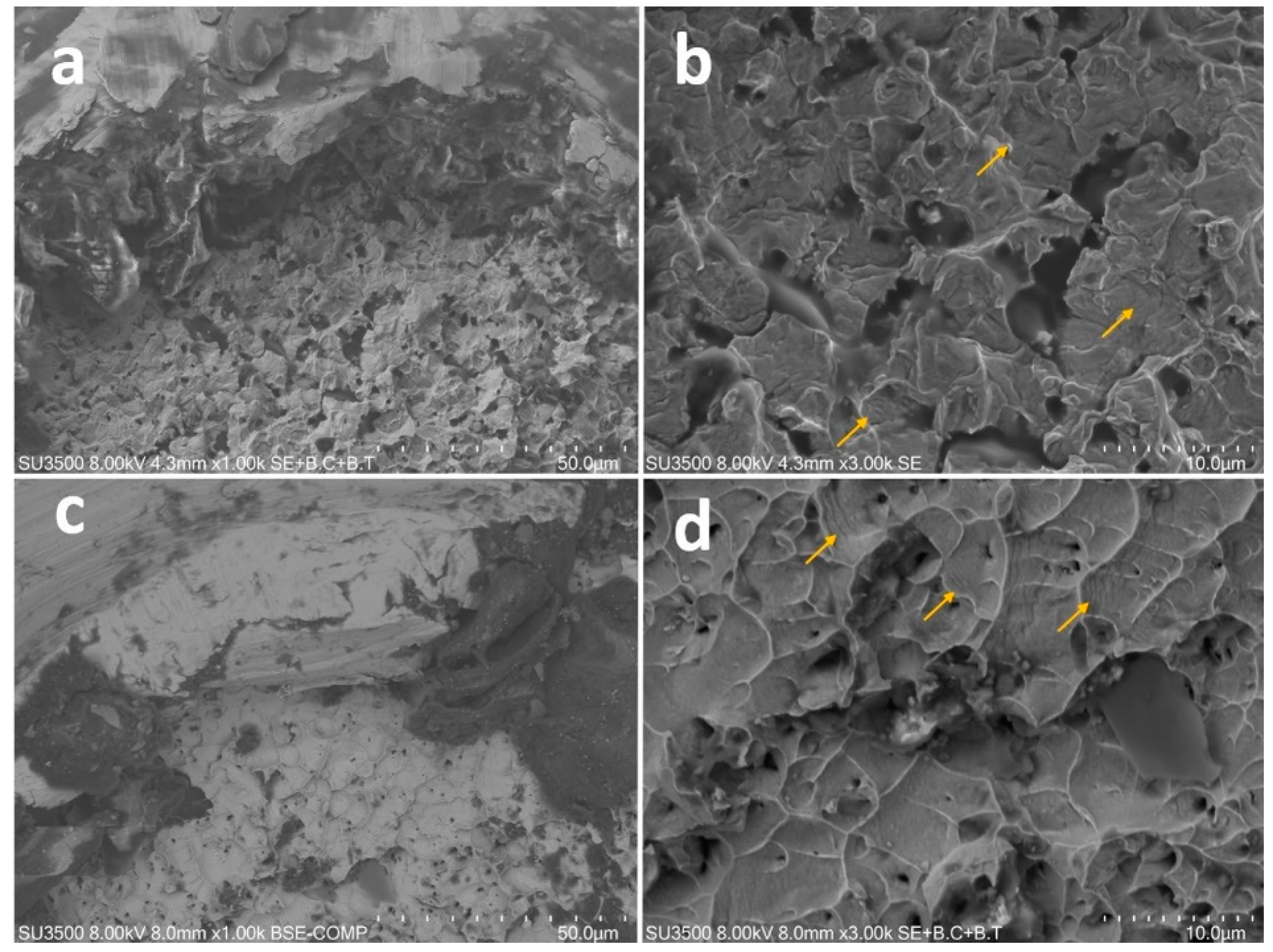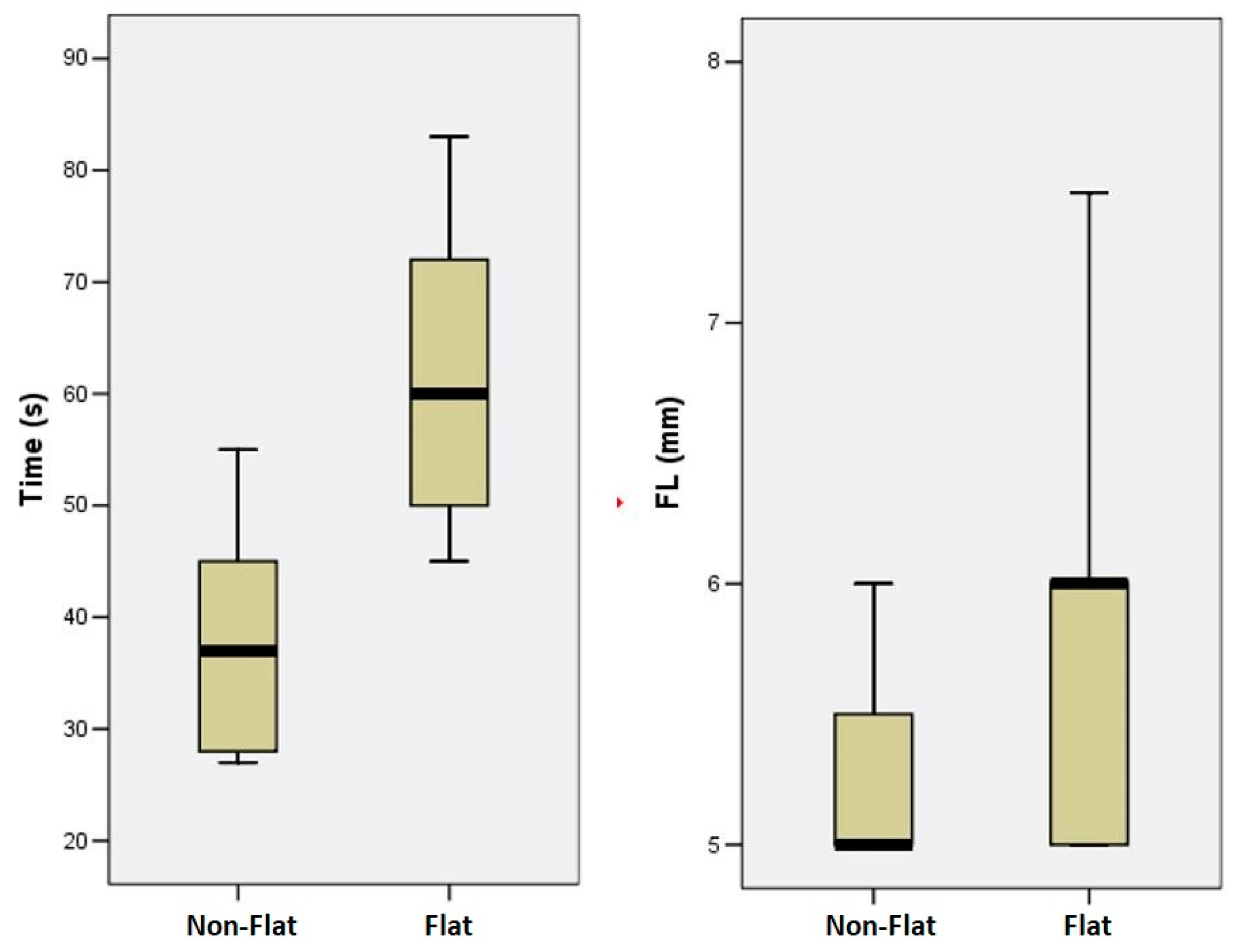Role of the Flat-Designed Surface in Improving the Cyclic Fatigue Resistance of Endodontic NiTi Rotary Instruments
Abstract
1. Introduction
2. Materials and Methods
3. Results
4. Discussion
5. Conclusions
Author Contributions
Funding
Acknowledgments
Conflicts of Interest
References
- Parashos, P.; Messer, H.H. Rotary NiTi instrument fracture and its consequences. J. Endod. 2006, 32, 1031–1043. [Google Scholar] [CrossRef] [PubMed]
- Kumar, B.S.; Pattanshetty, S.; Prasad, M.; Soni, S.; Pattanshetty, K.S.; Prasad, S. An in-vitro evaluation of canal transportation and centering ability of two rotary nickel titanium systems (twisted files and hyflex files) with conventional stainless steel hand k-flexofiles by using spiral computed tomography. J. Int. Oral. Health. 2013, 5, 108–115. [Google Scholar] [PubMed]
- Hidalgo, L.R.D.C.; Silva, L.A.B.D.; Leoni, G.B.; Mazzi-Chaves, J.F.; Carvalho, E.E.D.S.; Consolaro, A.; Sousa-Neto, M.D. Mechanical preparation showed superior shaping ability than manual technique in primary molars—A micro-computed tomography study. Braz. Dent. J. 2017, 28, 453–460. [Google Scholar] [CrossRef] [PubMed]
- Piao, J.; Miyara, K.; Ebihara, A.; Nomura, N.; Hanawa, T.; Suda, H. Correlation between cyclic fatigue and the bending properties of nickel titanium endodontic instruments. Dent. Mater. J. 2014, 33, 539–544. [Google Scholar] [CrossRef] [PubMed]
- Gambarini, G.; Seracchiani, M.; Piasecki, L.; Valenti Obino, F.; Galli, M.; Di Nardo, D.; Testarelli, L. Measurement of torque generated during intracanal instrumentation in vivo. Int. Endod. J. 2019, 52, 737–745. [Google Scholar] [CrossRef] [PubMed]
- Gambarini, G. Rationale for the use of low-torque endodontic motors in root canal instrumentation. Endod. Dent. Traumatol. 2000, 16, 95–100. [Google Scholar] [CrossRef] [PubMed]
- Di Nardo, D.; Galli, M.; Morese, A.; Seracchiani, M.; Ferri, V.; Miccoli, G.; Gambarini, G.; Testarelli, L. A comparative study of mechanical resistance of two reciprocating files. J. Clin. Exp. Dent. 2019, 11, e231–e235. [Google Scholar] [CrossRef] [PubMed]
- Dietz, D.B.; Di Fiore, P.M.; Bahcall, J.K.; Lautenschlager, E.P. Effect of rotational speed on the breakage of nickel-titanium rotary files. J. Endod. 2000, 26, 68–71. [Google Scholar] [CrossRef]
- Miccoli, G.; Gaimari, G.; Seracchiani, M.; Morese, A.; Khrenova, T.; Di Nardo, D. In vitro resistance to fracture of two nickel-titanium rotary instruments made with different thermal treatments. Ann. Stomatol. 2017, 8, 53–58. [Google Scholar]
- Zinelis, S.; Darabara, M.; Takase, T.; Ogane, K.; Papadimitriou, G.D. The effect oft hermal treatment on the resistance of nickel-titanium rotary files in cyclic fatigue. Oral. Surg. Oral. Med. Oral. Pathol. Oral. Radiol. Endod. 2007, 103, 843–847. [Google Scholar] [CrossRef]
- Plotino, G.; Grande, N.M.; Testarelli, L.; Gambarini, G. Cyclic fatigue of Reciproc and WaveOne reciprocating instruments. Int. Endod. J. 2012, 45, 614–618. [Google Scholar] [CrossRef]
- Gambarini, G.; Piasecki, L.; Miccoli, G.; Gaimari, G.; Di Giorgio, R.; Di Nardo, D.; Azim, A.A.; Testarelli, L. Classification and cyclic fatigue evaluation of new kinematics for endodontic instruments. Aust. Endod. J. 2018, (in press). [CrossRef]
- Gambarini, G.; Plotino, G.; Piasecki, L.; Al-Sudani, D.; Testarelli, L.; Sannino, G. Deformations and cyclic fatigue resistance of nickel-titanium instruments inside a sequence. Ann. Stomatol. 2015, 6, 6–9. [Google Scholar] [CrossRef]
- Gambarini, G.; Di Nardo, D.; Miccoli, G.; Guerra, F.; Di Giorgio, R.; Di Giorgio, G.; Glassman, G.; Piasecki, L.; Testarelli, L. The Influence of a new clinical motion for endodontic instruments on the incidence of postoperative pain. Clin. Ter. 2017, 168, e23–e27. [Google Scholar]
- Pedullà, E.; Plotino, G.; Scibilia, M.; Grande, N.M.; De Santis, D.; Pardo, A.; Testarelli, L.; Gambarini, G. Cyclic fatigue comparison among endodontic instruments with similar cross section and different surface coating. Minerva. Stomatol. 2019, 68, 67–73. [Google Scholar] [CrossRef]
- Musikant, B.L.; Cohen, B.I.; Deutsch, A.S. Comparison instrumentation reamers and files versus a flat-sided design of conventional noninterrupted, flat-sided design. J. Endod. 2004, 30, 107–109. [Google Scholar] [CrossRef]
- Wan, J.; Rasimick, B.J.; Musikant, B.L.; Deutsch, A.S. Cutting efficiency of 3 different instrument designs used in reciprocation. Oral. Surg. Oral. Med. Oral. Pathol. Oral. Radiol. Endod. 2010, 109, e82–e85. [Google Scholar] [CrossRef]
- Giansiracusa Rubini, A.; Plotino, G.; Al-Sudani, D.; Grande, N.M.; Sonnino, G.; Putorti, E.; Cotti, E.; Testarelli, L.; Gambarini, G. A new device to test cutting efficiency of mechanical endodontic instruments. Med. Sci. Monit. 2014, 20, 374–378. [Google Scholar]
- Gambarini, G.; Miccoli, G.; Seracchiani, M.; Morese, A.; Piasecki, L.; Gaimari, G.; Di Nardo, D.; Testarelli, L. Fatigue resistance of new and used nickel-titanium rotary instruments: A comparative study. Clin. Ter. 2018, 169, e96–e101. [Google Scholar]
- Troiano, G.; Dioguardi, M.; Cocco, A.; Giannatempo, G.; Laino, L.; Ciavarella, D.; Berutti, E.; Lo Muzio, L. Influence of operator’s experience on the shaping ability of protaper universal and waveone systems: A comparative study on simulated root canals. Open. Dent. J. 2016, 10, 546–552. [Google Scholar] [CrossRef]
- Al-Sudani, D.; Grande, N.M.; Plotino, G.; Pompa, G.; Di Carlo, S.; Testarelli, L.; Gambarini, G. Cyclic fatigue of nickel-titanium rotary instruments in a double (S-shaped) simulated curvature. J. Endod. 2012, 38, 987–989. [Google Scholar] [CrossRef]
- Plotino, G.; Grande, N.M.; Melo, M.C.; Bahia, M.G.; Testarelli, L.; Gambarini, G. Cyclic fatigue of NiTi rotary instruments in a simulated apical abrupt curvature. Int. Endod. J. 2010, 43, 226–230. [Google Scholar] [CrossRef]
- Viana, A.C.; Chaves Craveiro de Melo, M.; Guiomar de Azevedo Bahia, M.; Lopes Buono, V.T. Relationship between flexibility and physical, chemical, and geometric characteristics of rotary nickel-titanium instruments. Oral. Surg. Oral. Med. Oral. Pathol. Oral. Radiol. Endod. 2010, 110, 527–533. [Google Scholar] [CrossRef]
- Grande, N.M.; Plotino, G.; Pecci, R.; Bedini, R.; Malagnino, V.A.; Somma, F. Cyclic fatigue resistance and three-dimensional analysis of instruments from two nickel-titanium rotary systems. Int. Endod. J. 2006, 39, 755–763. [Google Scholar] [CrossRef]
- Pongione, G.; Pompa, G.; Milana, V.; Di Carlo, S.; Giansiracusa, A.; Nicolini, E.; De Angelis, F. Flexibility and resistance to cyclic fatigue of endodontic instruments made with different nickel-titanium alloys: A comparative test. Ann. Stomatol. 2012, 3, 119–122. [Google Scholar]
- Plotino, G.; Grande, N.M.; Cordaro, M.; Testarelli, L.; Gambarini, G. Measurement of the trajectory of different NiTi rotary instruments in an artificial canal specifically designed for cyclic fatigue tests. Oral. Surg. Oral. Med. Oral. Pathol. Oral. Radiol. Endod. 2009, 108, e152–e156. [Google Scholar] [CrossRef]
- De-Deus, G.; Leal Vieira, V.T.; Nogueira da Silva, E.J.; Lopes, H.; Elias, C.N.; Moreira, E.J. Bending resistance and dynamic and static cyclic fatigue life of Reciproc and WaveOne large instruments. J. Endod. 2014, 40, 575–579. [Google Scholar] [CrossRef]
- Palma, P.J.; Messias, A.; Cerqueira, A.R.; Tavares, L.D.; Caramelo, F.; Roseiro, L.; Santos, J.M. Cyclic fatigue resistance of three rotary file systems in a dynamic model after immersion in sodium hypochlorite. Odontology. 2019, 107, 324–332. [Google Scholar] [CrossRef]
- Alcalde, M.P.; Duarte, M.A.H.; Bramante, C.M.; de Vasconselos, B.C.; Tanomaru-Filho, M.; Guerreiro-Tanomaru, J.M.; Pinto, J.C.; Só, M.V.R.; Vivan, R.R. Cyclic fatigue and torsional strength of three different thermally treated reciprocating nickel-titanium instruments. Clin. Oral. Investig. 2018, 22, 1865–1871. [Google Scholar] [CrossRef]
- Plotino, G.; Grande, N.M.; Mercadé Bellido, M.; Testarelli, L.; Gambarini, G. Influence of Temperature on Cyclic Fatigue Resistance of ProTaper Gold and ProTaper Universal Rotary Files. J. Endod. 2017, 43, 200–202. [Google Scholar] [CrossRef]
- Dosanjh, A.; Paurazas, S.; Askar, M. The Effect of Temperature on Cyclic Fatigue of Nickel-titanium Rotary Endodontic Instruments. J. Endod. 2017, 43, 823–826. [Google Scholar] [CrossRef]
- Braga, L.C.; Faria Silva, A.C.; Buono, V.T.; de Azevedo Bahia, M.G. Impact of heat treatments on the fatigue resistance of different rotary nickel-titanium instruments. J. Endod. 2014, 40, 1494–1497. [Google Scholar] [CrossRef]
- Plotino, G.; Grande, N.M.; Mazza, C.; Petrovic, R.; Testarelli, L.; Gambarini, G. Influence of size and taper of artificial canals on the trajectory of NiTi rotary instruments in cyclic fatigue studies. Oral. Surg. Oral. Med. Oral. Pathol. Oral. Radiol. Endod. 2010, 109, 60–66. [Google Scholar] [CrossRef]
- Gambarini, G.; Gergi, R.; Grande, N.M.; Osta, N.; Plotino, G.; Testarelli, L. Cyclic fatigue resistance of newly manufactured rotary nickel titanium instruments used in different rotational directions. Aust. Endod. J. 2013, 39, 151–154. [Google Scholar] [CrossRef]
- Gambarini, G.; Di Nardo, D.; Galli, M.; Seracchiani, M.; Donfrancesco, O.; Testarelli, L. Differences in cyclic fatigue lifespan between two different heat treated NiTi endodontic rotary instruments: WaveOne Gold vs EdgeOne Fire. J. Clin. Exp. Dent. 2019, 11, e609–e613. [Google Scholar]
- Gambarini, G.; Piasecki, L.; Ropini, P.; Miccoli, G.; Di Nardo, D.; Testarelli, L. Cone-beam computed tomographic analysis on root and canal morphology of mandibular first permanent molar among multiracial population in Western European population. Eur. J. Dent. 2018, 12, 434–438. [Google Scholar]
- Valenti-Obino, F.; Di Nardo, D.; Quero, L.; Miccoli, G.; Gambarini, G.; Testarelli, L.; Galli, M. Symmetry of root and root canal morphology of mandibular incisors: A cone-beam computed tomography study in vivo. J. Clin. Exp. Dent. 2019, 11, e527–e533. [Google Scholar] [CrossRef]




| Specimen | 25.04 F-One | 25.04 Prototype | |
|---|---|---|---|
| TtF (s) | FL (mm) | FL (mm) | |
| 1 | 45 | 5 | 5 |
| 2 | 50 | 5 | 5 |
| 3 | 60 | 7.5 | 6 |
| 4 | 72 | 6 | 5.5 |
| 5 | 83 | 6 | 5 |
| 6 | 45 | 5 | 5 |
| 7 | 50 | 5 | 5 |
| 8 | 60 | 7.5 | 6 |
| 9 | 72 | 6 | 5.5 |
| 10 | 83 | 6 | 5 |
| 11 | 45 | 5 | 5 |
| 12 | 50 | 5 | 5 |
| 13 | 60 | 7.5 | 6 |
| 14 | 72 | 6 | 5.5 |
| 15 | 83 | 6 | 5 |
| 16 | 45 | 5 | 5 |
| 17 | 50 | 5 | 5 |
| 18 | 60 | 7.5 | 6 |
| 19 | 72 | 6 | 5.5 |
| 20 | 83 | 6 | 5 |
| MEAN | 62 | 5.9 | 5.3 |
| SD | 15.63649577 | 1.302469508 | 0.45 |
© 2019 by the authors. Licensee MDPI, Basel, Switzerland. This article is an open access article distributed under the terms and conditions of the Creative Commons Attribution (CC BY) license (http://creativecommons.org/licenses/by/4.0/).
Share and Cite
Gambarini, G.; Miccoli, G.; Seracchiani, M.; Khrenova, T.; Donfrancesco, O.; D’Angelo, M.; Galli, M.; Di Nardo, D.; Testarelli, L. Role of the Flat-Designed Surface in Improving the Cyclic Fatigue Resistance of Endodontic NiTi Rotary Instruments. Materials 2019, 12, 2523. https://doi.org/10.3390/ma12162523
Gambarini G, Miccoli G, Seracchiani M, Khrenova T, Donfrancesco O, D’Angelo M, Galli M, Di Nardo D, Testarelli L. Role of the Flat-Designed Surface in Improving the Cyclic Fatigue Resistance of Endodontic NiTi Rotary Instruments. Materials. 2019; 12(16):2523. https://doi.org/10.3390/ma12162523
Chicago/Turabian StyleGambarini, Gianluca, Gabriele Miccoli, Marco Seracchiani, Tatyana Khrenova, Orlando Donfrancesco, Maurilio D’Angelo, Massimo Galli, Dario Di Nardo, and Luca Testarelli. 2019. "Role of the Flat-Designed Surface in Improving the Cyclic Fatigue Resistance of Endodontic NiTi Rotary Instruments" Materials 12, no. 16: 2523. https://doi.org/10.3390/ma12162523
APA StyleGambarini, G., Miccoli, G., Seracchiani, M., Khrenova, T., Donfrancesco, O., D’Angelo, M., Galli, M., Di Nardo, D., & Testarelli, L. (2019). Role of the Flat-Designed Surface in Improving the Cyclic Fatigue Resistance of Endodontic NiTi Rotary Instruments. Materials, 12(16), 2523. https://doi.org/10.3390/ma12162523









